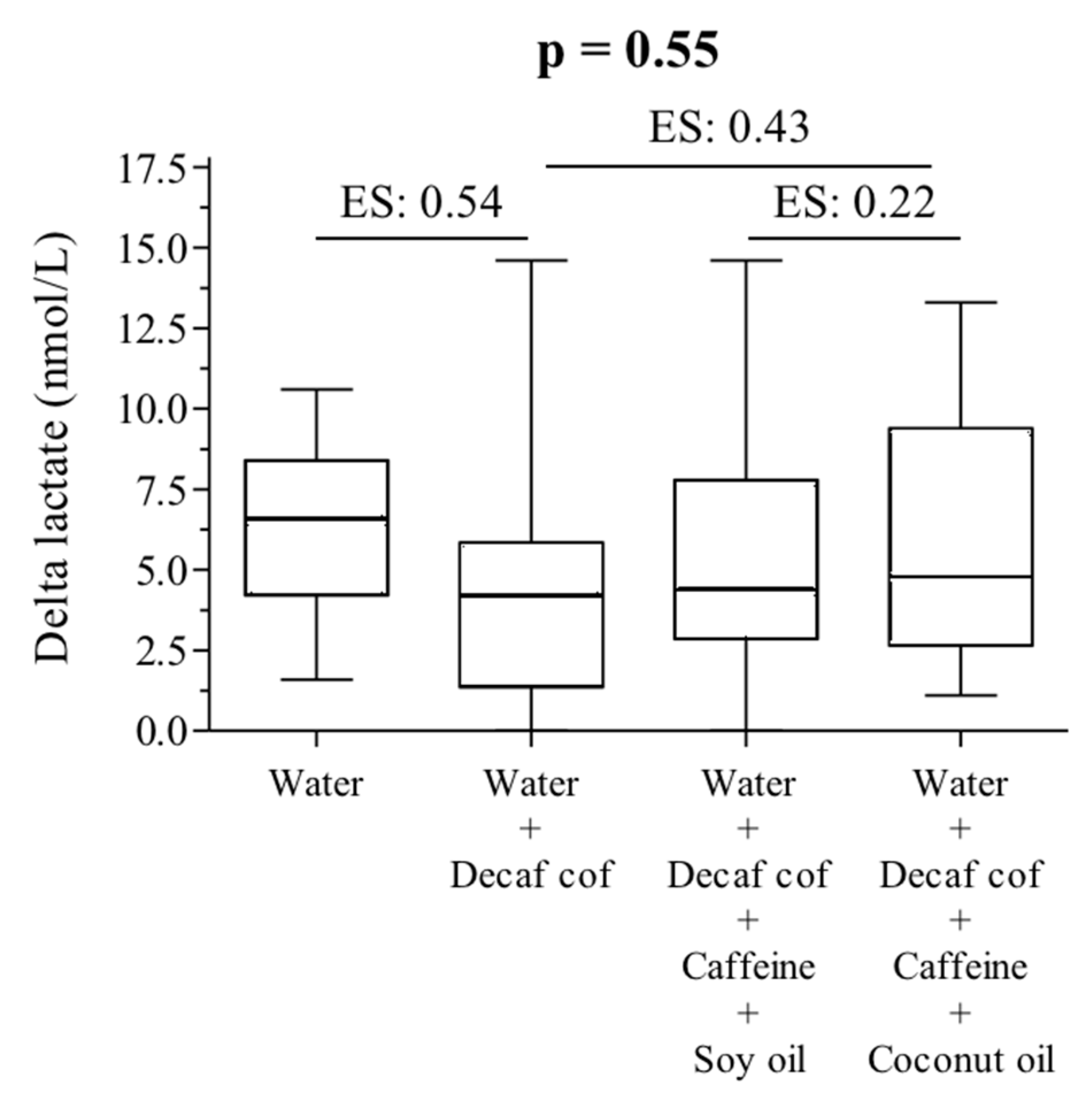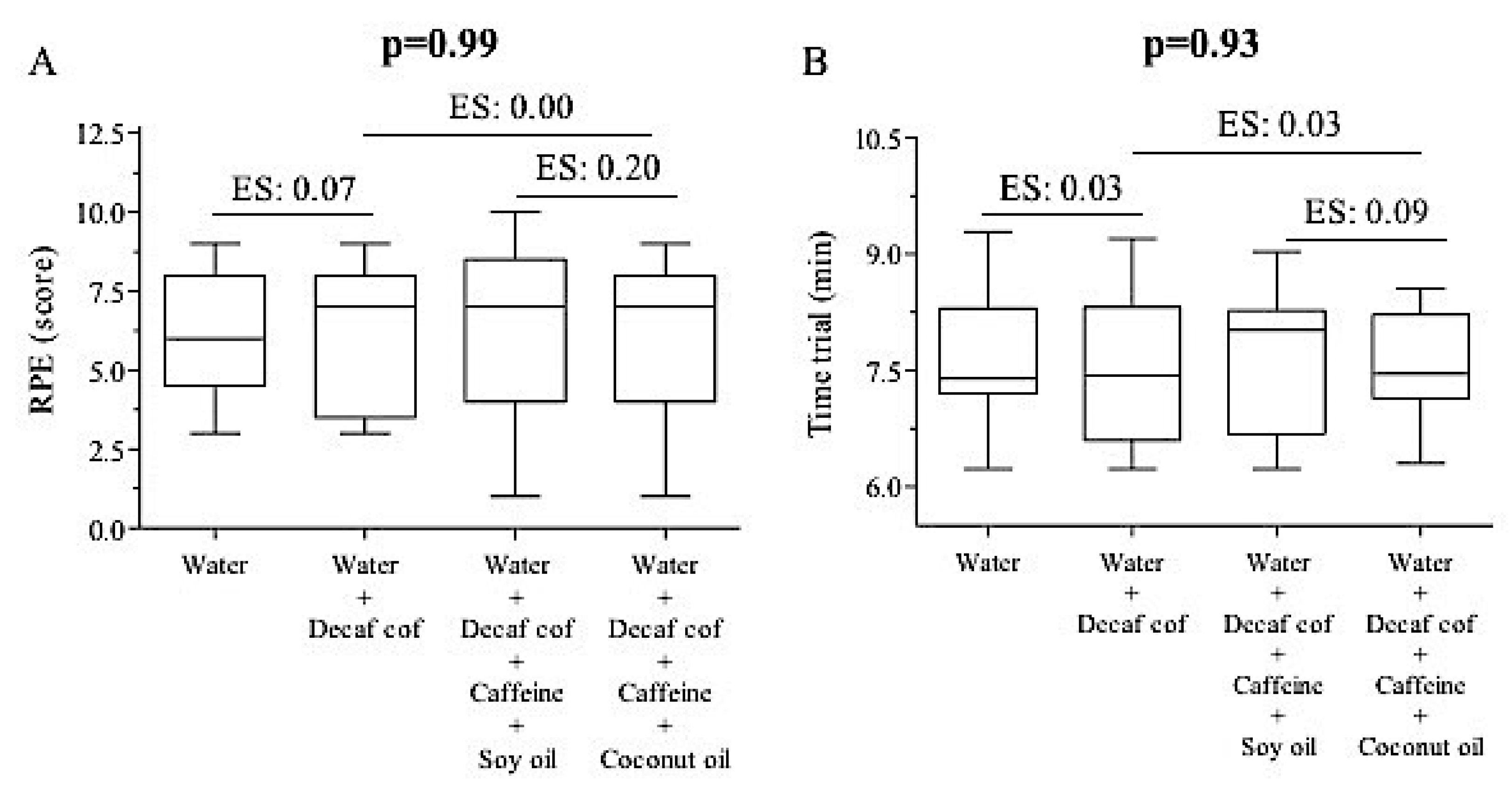Acute Caffeine and Coconut Oil Intake, Isolated or Combined, Does Not Improve Running Times of Recreational Runners: A Randomized, Placebo-Controlled and Crossover Study
Abstract
:1. Introduction
2. Methods
2.1. Subjects and Recruitment
2.2. Study Design
2.3. Supplementation
2.4. Evaluation of Food Sources of Caffeine and Dietary Intake
2.5. Running Trials
2.6. Anthropometry, Blood Lactate, and Rating of Perceived Effort (RPE) Assessment
2.7. Statistical Analyses
3. Results
4. Discussion
5. Conclusions
Author Contributions
Funding
Acknowledgments
Conflicts of Interest
References
- Thomas, D.; Erdman, K.; Burke, L.; American College of Sports Medicine; Academy of Nutrition and Dietetics; Dietitians of Canada. Joint Position Statement: Nutrition and athletic performance. Med. Sci. Sports Exerc. 2016, 48, 543–568. [Google Scholar]
- Peeling, P.; Binnie, M.J.; Goods, P.S.R.; Sim, M.; Burke, L.M. Evidence-based supplements for the enhancement of athletic performance. Int. J. Sport Nutr. Exerc. Metab. 2018, 28, 178–187. [Google Scholar] [CrossRef] [PubMed]
- Southward, K.; Rutherfurd-Markwick, K.J.; Ali, A. The Effect of Acute Caffeine Ingestion on Endurance Performance: A Systematic Review and Meta—Analysis. Sports Med. 2018, 48, 1913–1928. [Google Scholar] [CrossRef]
- Barnes, K.R. Strategies to improve running economy. Sports Med. 2015, 45, 37–56. [Google Scholar] [CrossRef] [PubMed]
- Marques, A.C.; Jesus, A.A.; Giglio, B.M.; Marini, A.C.; Lobo, P.C.B.; Mota, J.F.; Pimentel, G.D. Acute caffeinated coffee consumption does not improve time trial performance in an 800-m run: A randomized, double-blind, crossover, placebo-controlled study. Nutrients 2018, 10, 657. [Google Scholar] [CrossRef] [PubMed]
- Goldstein, E.R.; Ziegenfuss, T.; Kalman, D.; Kreider, R.; Campbell, B.; Wilborn, C.; Taylor, L.; Willoughby, D.; Stout, J.; Graves, B.S.; et al. International society of sports nutrition position stand: Caffeine and performance. J. Int. Soc. Sports Nutr. 2010, 7, 5. [Google Scholar] [CrossRef] [PubMed]
- Bishop, D. Dietary Supplements and Team-Sport Performance. Sports Med. 2010, 40, 995–1017. [Google Scholar] [CrossRef] [PubMed]
- Rogers, N.L.; Dinges, D.F. Caffeine: Implications for Alertness in Athletes. Clin. Sports Med. 2005, 24, e1–e13. [Google Scholar] [CrossRef] [PubMed]
- Loureiro, L.M.R.; Reis, C.E.G.; Da Costa, T.H.M. Effects of coffee components on muscle glycogen recovery: A systematic review. Int. J. Sport Nutr. Exerc. Metab. 2018, 28, 284–293. [Google Scholar] [CrossRef]
- Kinsella, R.; Maher, T.; Clegg, M.E. Coconut oil has less satiating properties than medium chain triglyceride oil. Physiol. Behav. 2017, 179, 422–426. [Google Scholar] [CrossRef]
- Denke, M.A.; Grundy, S.M. Comparison of effects of lauric acid and palmitic acid on plasma lipids and lipoproteins. Am. J. Clin. Nutr. 1992, 56, 895–898. [Google Scholar] [CrossRef] [PubMed] [Green Version]
- Berning, J.R. The Role of Medium-Chain Triglycerides in Exercise. Int. J. Sport Nutr. 1996, 6, 121–133. [Google Scholar] [CrossRef] [PubMed]
- Jeukendrup, A.E.; Aldred, S. Fat supplementation, health, and endurance performance. Nutrition 2004, 20, 678–688. [Google Scholar] [CrossRef] [PubMed]
- Clegg, M.E. Medium-chain triglycerides are advantageous in promoting weight loss although not beneficial to exercise performance. Int. J. Food Sci. Nutr. 2010, 61, 653–679. [Google Scholar] [CrossRef] [PubMed]
- Robinson, S.A.; O’Brien, M.W.; Grandy, S.A.; Heinze-Milne, S.; Kimmerly, D.S. Short-term supplement of virgin coconut oil improves endothelial-dependent dilation but not exercise-mediated hyperemia in young adults. Nutr. Res. 2019, 67, 17–26. [Google Scholar] [CrossRef] [PubMed]
- Shaw, D.M.; Merien, F.; Braakhuis, A.; Maunder, E.; Dulson, D.K. Effect of a Ketogenic Diet on Submaximal Exercise Capacity and Efficiency in Runners. Med. Sci. Sports Exerc. 2019. [Google Scholar] [CrossRef] [PubMed]
- Schneiker, K.T.; Bishop, D.; Dawson, B.; Hackett, L.P. Effects of caffeine on prolonged intermittent-sprint ability in team-sport athletes. Med. Sci. Sports Exerc. 2006, 38, 578–585. [Google Scholar] [CrossRef] [PubMed]
- Gonçalves, L.S.; Painelli, V.S.; Yamaguchi, G.; de Oliveira, L.F.; Saunders, B.; da Silva, R.P.; Maciel, E.; Artioli, G.G.; Roschel, H.; Gualano, B. Dispelling the myth that habitual caffeine consumption influences the performance response to acute caffeine supplementation. J. Appl. Physiol. 2017, 123, 213–220. [Google Scholar] [CrossRef] [Green Version]
- Kurobe, K.; Nakao, S.; Nishiwaki, M.; Matsumoto, N. Combined effect of coffee ingestion and repeated bouts of low-intensity exercise on fat oxidation. Clin. Physiol. Funct. Imaging 2017, 37, 148–154. [Google Scholar] [CrossRef]
- Rakvaag, E.; Dragsted, L.O. Acute effects of light and dark roasted coffee on glucose tolerance: A randomized, controlled crossover trial in healthy volunteers. Eur. J. Nutr. 2016, 55, 2221–2230. [Google Scholar] [CrossRef]
- Landrum, R.E. College students’ use of caffeine and its relationship to personality. Coll. Stud. J. 1992, 24, 151–155. [Google Scholar]
- Jackson, A.S.; Pollock, M.L. Generalized equations for predicting body density of men. Br. J. Nutr. 1978, 40, 497–504. [Google Scholar] [CrossRef] [Green Version]
- Jackson, A.S.; Pollock, M.L.; Ward, A. Generalized equations for predicting body density of women. Med. Sci. Sports Exerc. 1980, 12, 175–182. [Google Scholar] [CrossRef]
- Borg, G.A. Psychophysical bases of perceived exertion. Med. Sci. Sports Exerc. 1982, 14, 377–381. [Google Scholar] [CrossRef]
- Cox, G.R.; Desbrow, B.; Montgomery, P.G.; Anderson, M.E.; Bruce, C.R.; Macrides, T.A.; Martin, D.T.; Moquin, A.; Roberts, A.; Hawley, J.A.; et al. Effect of different protocols of caffeine intake on metabolism and endurance performance. J. Appl. Physiol. 2002, 93, 990–999. [Google Scholar] [CrossRef] [Green Version]
- Butts, N.K.; Crowell, D. Effect of caffeine ingestion on cardiorespiratory endurance in men and women. Res. Q. Exerc. Sport 1985, 56, 301–305. [Google Scholar] [CrossRef]
- Graham, T.E.; Hibbert, E.; Sathasivam, P. Metabolic and exercise endurance effects of coffee and caffeine ingestion. J. Appl. Physiol. 1998, 85, 883–889. [Google Scholar] [CrossRef]
- Hodgson, A.B.; Randell, R.K.; Jeukendrup, A.E. The Metabolic and Performance Effects of Caffeine Compared to Coffee during Endurance Exercise. PLoS ONE 2013, 8, e59561. [Google Scholar] [CrossRef]
- Church, D.D.; Hoffman, J.R.; LaMonica, M.B.; Riffe, J.J.; Hoffman, M.W.; Baker, K.M.; Varanoske, A.N.; Wells, A.J.; Fukuda, D.H.; Stout, J.R. The effect of an acute ingestion of Turkish coffee on reaction time and time trial performance. J. Int. Soc. Sports Nutr. 2015, 12, 37. [Google Scholar] [CrossRef] [Green Version]
- Gollnick, P.D.; Bayly, W.M.; Hodgson, D.R. Exercise intensity, training, diet, and lactate concentration in muscle and blood. Med. Sci. Sports Exerc. 1986, 18, 334–340. [Google Scholar] [CrossRef] [Green Version]
- Resende, N.M.; Félix, H.R.; Soré, M.R.; Neto, A.M.M.; Campos, K.E.; Volpato, G.T. The effects of coconut oil supplementation on the body composition and lipid profile of rats submitted to physical exercise. An. Acad. Bras. Cienc. 2016, 88, 933–940. [Google Scholar] [CrossRef] [PubMed] [Green Version]
- Raguso, C.A.; Coggan, A.R.; Sidossis, L.S.; Gastaldelli, A.; Wolfe, R.R. Effect of theophylline on substrate metabolism during exercise. Metabolism 1996, 45, 1153–1160. [Google Scholar] [CrossRef]
- Costa, G.D.C.T.; Galvão, L.; Bottaro, M.; Mota, J.F.; Pimentel, G.D.; Gentil, P. Effects of placebo on bench throw performance of Paralympic weightlifting athletes: A pilot study. J. Int. Soc. Sports Nutr. 2019, 16, 9. [Google Scholar] [CrossRef] [PubMed]
- Saunders, B.; de Oliveira, L.F.; da Silva, R.P.; de Salles Painelli, V.; Gonçalves, L.S.; Yamaguchi, G.; Mutti, T.; Maciel, E.; Roschel, H.; Artioli, G.G.; et al. Placebo in sports nutrition: A proof-of-principle study involving caffeine supplementation. Scand. J. Med. Sci. Sports 2017, 27, 1240–1247. [Google Scholar] [CrossRef] [PubMed]
- Hanson, N.J.; Martinez, S.C.; Byl, E.N.; Maceri, R.M.; Miller, M.G. Increased Rate of Heat Storage, and No Performance Benefits, With Caffeine Ingestion Before a 10-km Run in Hot, Humid Conditions. Int. J. Sports Physiol. Perform. 2019, 14, 196–202. [Google Scholar] [CrossRef] [PubMed]
- Lira, F.S.; Rossi, F.E.; de Oliveira, E.P.; Marini, A.C.B.; Mota, J.F.; Pimentel, G.D. Acute Caffeine Supplementation Does Not Change Sweat Rate and Blood Pressure in Ballet Dancers: A Double-Blind and Placebo-Controlled Study. J. Danc. Med. Sci. 2018, 22, 137–141. [Google Scholar] [CrossRef] [PubMed]



| Variables | Mean ± SD |
|---|---|
| Age (years) | 28.46 ± 5.63 |
| Body mass index (kg/m2) | 23.58 ± 3.90 |
| Waist circumference (cm) | 75.88 ± 11.24 |
| Body fat (%) | 16.19 ± 6.00 |
| Nutrients | Initial | Final | p |
|---|---|---|---|
| Calories (kcal) | 2439.28 ± 948.33 | 2298.50 ± 672.15 | 0.666 |
| Calories (kcal/kg) | 35.48 ± 9.78 | 35.04 ± 10.90 | 0.915 |
| Carbohydrate (%) | 47.64 ± 7.77 | 51.59 ± 17.06 | 0.455 |
| Carbohydrate (g) | 282.29 ± 107.88 | 288.68 ± 100.64 | 0.877 |
| Protein (%) | 20.19 ± 3.69 | 20.67 ± 5.93 | 0.807 |
| Protein (g) | 120.64 ± 51.67 | 117.47 ± 50.43 | 0.876 |
| Isoleucine (g) | 3.02 ± 1.93 | 3.16 ± 2.04 | 0.862 |
| Leucine (g) | 5.41 ± 3.37 | 5.77 ± 3.74 | 0.797 |
| Valine (g) | 3.51 ± 2.28 | 3.57 ± 2.21 | 0.954 |
| Lipids (%) | 32.72 ± 5.81 | 33.06 ± 9.27 | 0.913 |
| Lipids (g) | 92.23 ± 48.02 | 82.15 ± 26.42 | 0.858 |
| Water intake (L) | 2.10 ± 1.01 | 2.06 ± 0.82 | 0.856 |
© 2019 by the authors. Licensee MDPI, Basel, Switzerland. This article is an open access article distributed under the terms and conditions of the Creative Commons Attribution (CC BY) license (http://creativecommons.org/licenses/by/4.0/).
Share and Cite
Borba, G.d.L.; Batista, J.S.d.F.; Novais, L.M.Q.; Silva, M.B.; Silva Júnior, J.B.d.; Gentil, P.; Marini, A.C.B.; Giglio, B.M.; Pimentel, G.D. Acute Caffeine and Coconut Oil Intake, Isolated or Combined, Does Not Improve Running Times of Recreational Runners: A Randomized, Placebo-Controlled and Crossover Study. Nutrients 2019, 11, 1661. https://doi.org/10.3390/nu11071661
Borba GdL, Batista JSdF, Novais LMQ, Silva MB, Silva Júnior JBd, Gentil P, Marini ACB, Giglio BM, Pimentel GD. Acute Caffeine and Coconut Oil Intake, Isolated or Combined, Does Not Improve Running Times of Recreational Runners: A Randomized, Placebo-Controlled and Crossover Study. Nutrients. 2019; 11(7):1661. https://doi.org/10.3390/nu11071661
Chicago/Turabian StyleBorba, Gabrielle de Lima, Julianne Soares de Freitas Batista, Ludmilla Marques Queiroz Novais, Myrnzzia Beatriz Silva, João Batista da Silva Júnior, Paulo Gentil, Ana Clara Baretto Marini, Bruna Melo Giglio, and Gustavo Duarte Pimentel. 2019. "Acute Caffeine and Coconut Oil Intake, Isolated or Combined, Does Not Improve Running Times of Recreational Runners: A Randomized, Placebo-Controlled and Crossover Study" Nutrients 11, no. 7: 1661. https://doi.org/10.3390/nu11071661
APA StyleBorba, G. d. L., Batista, J. S. d. F., Novais, L. M. Q., Silva, M. B., Silva Júnior, J. B. d., Gentil, P., Marini, A. C. B., Giglio, B. M., & Pimentel, G. D. (2019). Acute Caffeine and Coconut Oil Intake, Isolated or Combined, Does Not Improve Running Times of Recreational Runners: A Randomized, Placebo-Controlled and Crossover Study. Nutrients, 11(7), 1661. https://doi.org/10.3390/nu11071661






